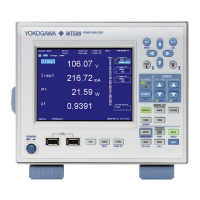Explanation
A display example is shown below. When the displayed measurement function is U, I, P, S,
or Q, the vertical axis is in logarithmic scale. The words “log Scale” appear at the top of
the screen.
U or I, for voltage or current;
the element number; and the upper
limit of the displayed bar graph
U or I, for voltage or current;
the element number; and the lower
limit of the displayed bar graph
Harmonic order range
of the displayed bar graph
<log Scale>
Changing a Measurement Function
The following measurement functions can be changed.
(U, I, P, S, Q,
λ
,
f
,
f
U,
f
I)
Changing an Element
You can select an element from one of the choices below. The selectable items vary
depending on the number of elements installed in the WT500.
Element1, Element2, and Element3
Selecting Which Bar Graphs to Display
There are three bar graphs. You can set which bar graphs are displayed (from Graph1 to
Graph3) by changing the number of split screens in the bar graph display.
Note
• If a value is negative on the log scale, its absolute value is displayed with a red bar graph.
• If the analysis window width (number of cycles of the fundamental signal) that is determined
by the fundamental frequency is shorter than the data update interval, bar graphs are not
displayed. If this happens, decrease the data update rate. The details are the same as with
harmonic data. For more information, see the “Note” part of section 6.2.
6.7 Displaying Bar Graphs and Making Cursor Measurements

